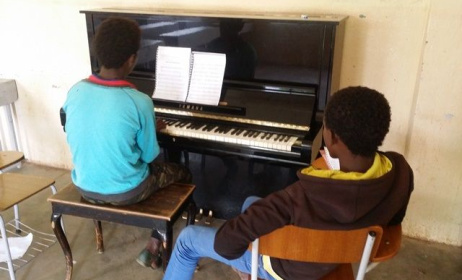Guitar lesson 4: Bar chords
An open chord is a chord that uses open strings. When you try to move an open chord up the fingerboard, it becomes difficult as the open strings will not correspond to the rest of the notes you have to press to play the chord.
 Bar chord. Photo: www.guitarhabits.com
Bar chord. Photo: www.guitarhabits.com
For this reason guitarists use the 1st finger as a bar across the fretboard to act as a new nut fret. The bar you create with your finger presses more than one string at the same time. The bar is indicated by a black strip in the TAB below.
Bar chords enable you to play the open position chords easily all the way up the fingerboard in different positions and mastering them will greatly increase your options as a guitarist whatever style of music you prefer.
Major chord bar positions
Here are three positions for a Major bar chord. In each position the length of the bar used changes. The Ist position starts on the 3rd fret, the 2nd position on the 8th fret and the last position starts on the 12th fret.
Exercise 1: Major bar chord in three positions
It is important to practice the Major bar chords in all the positions. Simply transpose each position in the minor bar chord a half step up or down to change to the next chord with a different root or bass note (going up C – C# or going down C - B). Make sure you practice all three positions on each new bass note till you are ver comfortable.
Minor chord bar positions
Minor bar chords work exactly the same way as Major bar chords but the Major 3rd is lowered a half step to a minor third.
Here are three positions for a Minor bar chord. In each position the length of the bar changes. The 1st position starts on the 3rd fret, the 2nd position on the 8th fret and the last position starts on the 10th fret.
Exercise 2: Minor bar chord in three positions
It is advantageous to play the bar chords on all the parts of the fingerboard and explore. It is therefore important to practice the Minor bar chords in all the positions. Simply transpose each position in the minor bar chord a half step up or down to change to the next chord with a different root or bass note (going up C – C# or going down C - B). Make sure you practice all three positions on each new bass note till you are very comfortable.
The rhythm guitar concept
Performing guitar is not all about playing melody. Learning the art of playing good rhythm guitar and providing accompaniment is an invaluable skill. Rhythm guitar has two roles:
- To provide all or part of the harmony
- To provide all or part of the rhythmic pulse
More developed guitar rhythm techniques extend into arpeggios, damping, etc..
When practicing rhythm guitar, one common mistake beginners make is to focus only on the pluck hand strumming the chords and ignore the fret hand which holds the chords. What actually happens is that the bridge hand strums the rhythmic sub-divisions consistently in auto pilot mode while the fret hand plays the rhythm by holding and releasing the chords / group of strings. The fret hand also determines how long the chord rings for. So the fret hand has a double function, to provide the harmony and to produce the accents for the rhythm.
Now let’s look at the following exercise for basic rhythm guitar. In this exercise play the subdivisions of the rhythm with the bridge hand (right hand) while damping the guitar strings with the fret hand (left hand). Practice this for a while until the movement becomes effortless and agility is achieved. Then begin to add the rhythmic accents that characterize the particular guitar rhythm with your fret hand. Use any chord or any combination of chords
Exercise 3: Rhythm guitar exercise in 4/4
Exercise 4: Rhythm guitar exercise in 6/8
Steps:
- Practice first the Bridge Hand only with strings muted with the Fret Hand (this will be the default position for the FH at any given time where there are no hits)
- Practice rhythm guitar co-ordinating both hands at a slow and comfortable tempo and slowly increase the speed.
- Try to experiment by varying the rhythmic hits with your Fret Hand.
Conclusion
Mastering bar chords and using them to play rhythm guitar is essential. It is not easy to get the pressure evenly spread on your bar finger so that the chord sounds good and all the notes come through clearly. By pressing too hard you can damage the tendons in your fret hand, so it is important to develop this technique slowly and carefully through regular practice every day. Once you have developed the strength in your hand, it will become much easier.
Check the position of the bridge on your guitar as well: if it is too high, you will have to use too much pressure with your fret hand. If it is too low, the strings will buzz.
If you have a feeling something is wrong, take the instrument to a repair shop. The neck or bridge or both may need adjusting. Playing on a badly adjusted instrument can result in permanent damage to the tendons in your fret hand and may also result in intense back problems later in your life.






























Commentaires
s'identifier or register to post comments